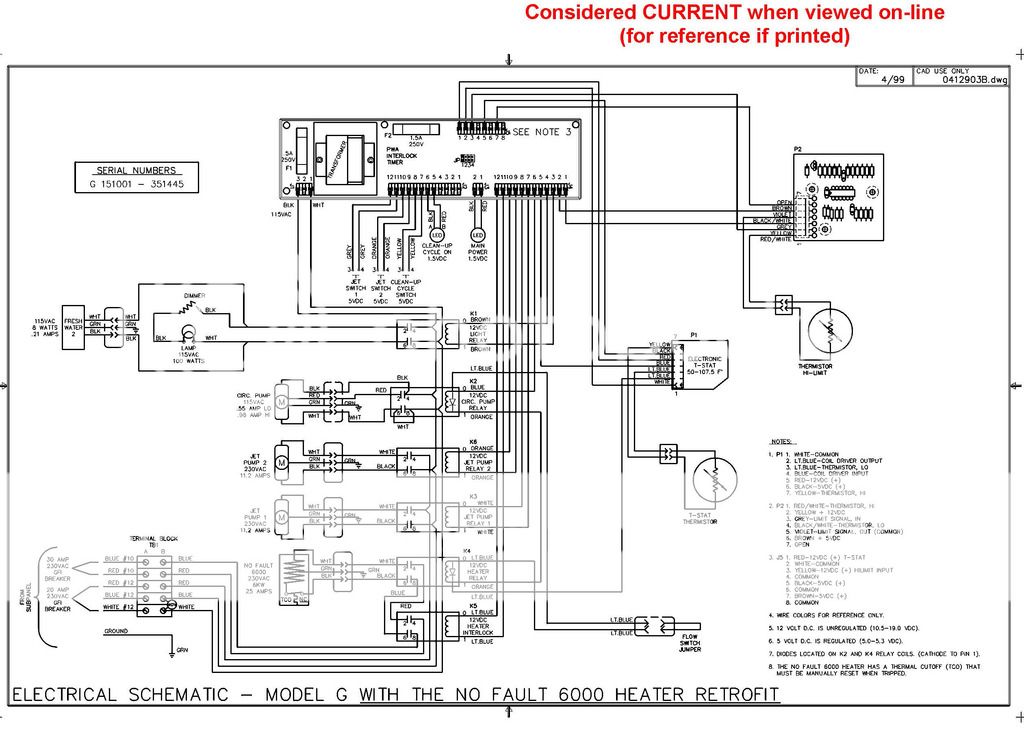Hi everyone. Brand new to the forum. First post.
First of all I should say this is not an automotive question but it is a 12V DC problem so I hope the experts in this forum will be willing to take a look at this problem. I have done lots of searching on the internet for a solution to this problem but I have not found one anywhere. I hope the experts on this forum will be able to help me find a solution here.
This actually has to do with my hot tub. Here's the background information you'll need to know before you'll understand what the problem is that I need to solve: Below is the electrical schematic for the tub. As you can see, the jet pumps are triggered by a NO non-latching SPDT relay that uses a 12V DC control signal. Basically, you push the control panel button to turn the pump on, 12V DC is put to the relay, the relay latches and 230 V AC goes to the jet pump. Once you push the button again, no more 12V to the relay, the relay unlatches and pump is off. Pretty simple.
I am planning on installing a DIY chlorinating system to the tub. Basically, I'll be using a wifi enabled Sonoff 4 channel switching system that I will use to turn on and off a 12V DC dose pump that will inject the chlorine into the circulation pump line over the internet using my smartphone or tablet. Once the chlorine has been injected, I want to also be able to turn each of the jet pumps on, let them run a couple minutes to mix the chlorine and then shut them off again.
To make the jet pumps turn on and off using the Sonoff will be easy. All I have to do is set up one of the 4 switches to send 12V to one of the jet pump control relays when I tell it to do that from my mobile device. Then I just need to tell the Sonoff to stop sending 12V to the relay to turn the jet pump off. I will set up a switch for each jet pump so I can control each one individually. To begin with, this will be a "dumb" system where I will manually control everything and there will be no sensor in the tub to tell me or the switching system what the chlorine level is in the water so there is no automation.
In a later phase of the project, however, I would like to fully automate the system using a probe that measures chlorine levels in the water, tie that probe to a Raspberry Pi or Arduino and have that unit make the Sonoff run the dose pump to inject chlorine and then mix it with the jet pumps. In other words, the system will monitor chlorine levels and inject more as needed to keep the levels within a preset range. It is in this scenario that I could run into a problem; the chlorine injection system may decide to inject the chlorine and run the jet pumps when the jet pumps are already on. In that scenario, the control relay will be getting a 12V input signal from the tub and then if the Sonoff tries to turn the jet pumps on, it will send another 12V to the control relay. That's 24V going to a relay designed to only accomodate a 12V DC control signal. My guess is that'll blow up the relay.
So what I want to do is somehow set up a relay or switching system where I can have the 12V trigger wires from the tub and the Sonoff go into and it will send 12V to the jet pump control relay when either of them sends 12V but will never let 24V go to the relay if both happen to be sending 12V at the same time. In other words, it will allow either input to send 12V to the relay but will not allow both to send 12V at the same time. If one side is sending 12V to the relay then the other can't.
Can anyone suggest how I can accomplish this say by using a pair of relays or some other means?
 I Can Take Anything Apart
I Can Take Anything Apart
 Printable version
Printable version

















